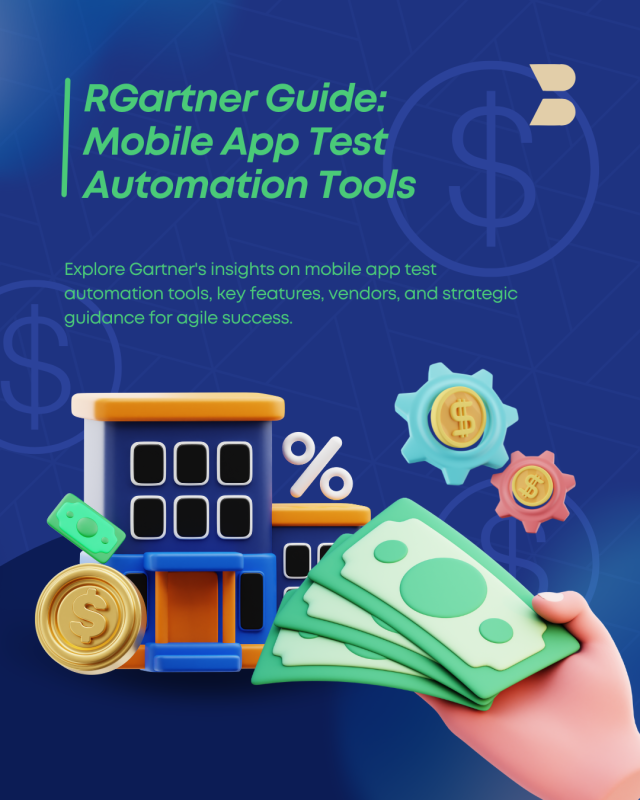While mobile applications are an essential part of contemporary business strategy, giving customers a seamless and enjoyable user experience, developing high-quality functional end-user apps requires patience and hard work. However, testing and QA add even more challenges to this landscape for a typical organization developing an app solo because this process takes resources and effort which strain business departments.
So who eats that time cost in turn developing quality but with a rushed version as opposed to if it should be when employed automation tools which people have to maintain in real life and still not reap benefits out of years later on?
Today we have mobile app test automation tools, which enable companies to maintain quality while still meeting the rapid delivery speed demands of agile. This is something that has been long anticipated. Gartner, a trusted authority in technology research, has brought the publication “Market Guide for Mobile App Test Automation Tools“ to the public.
This guide is intended to show all how you can look at just what Gartner knows and how it could benefit your organization. But just what exactly does this guide outline? And more importantly, why does it matter for your business?
What Is the Gartner Market Guide?

What’s important is not to dissect the Gartner Market Guide for Mobile App Test Automation Tools wrongly.
A leading research and advisory firm, Gartner releases Market Guides to help bring clarity into ever-changing technology markets. Unlike their Magic Quadrant which is a review of well-established vendors, the Market Guides concentrate on emerging markets or new technological ideas. They explain critical trends and analyze the key players, giving good thoughts for the top future directions.
The Market Guide for Mobile App Test Automation Tools gives companies an understanding of the varied landscape of mobile app testing solutions. It provides information on what market principals are doing, their offerings, and how things are progressing in the industry.
Whether your development team is exploring automation or your business is concretely fashioning a mobile-first strategy, this guide offers tips for taking action on for choosing resources that align with your goals.
Why Mobile App Testing Automation Matters
As consumer expectations continue to mount, mobile app test automation has moved beyond being a “nice-to-have.” It’s now a must. The following are the reasons why automation tools are so important in the success of mobile apps:
Releases Faster
Automation tools can cut down development deadlines by finishing repetitive testing on those that computers such tasks swiftly. This leaves developers free to focus on making shorter release cycles possible, even in continuous deployment or integrating pipelines (CI/CD).
Example: Automated regression testing ensures that new updates won’t interfere with existing functions, so you can roll out even more quickly and still have high quality.
High-Quality Assurance at Scale
Manually testing multiple apps across different platforms is likely to consume considerable resources—especially if you are an enterprise. Automation makes this scalable: tests can be concurrently run across multiple devices and operating systems.
Example: Tools like Browser Stack or Sauce Labs allow your testers to do hundreds of devices/browser combinations at once.
Efficiency in Cost
Initial configuration and maintenance of test automation may involve investment, but businesses realize long-term savings due to reductions in human resource expenditures for manual testing and the earlier catching of bugs in development.
Increased Precision
Automation reduces the chances of human error, thus making repetitive tasks like regression or performance testing performed uniformly each time.
A Customized Experience
Given the diversity of devices, OS’s, and usage circumstances, automation tools can be used to effectively mimic real-world usage. This produces a user experience that is completely seamless with what people expect from their products.
The Automated Testing Features of Mobile App Automation Tools

According to Gartner, an ideal test automation tool should possess the following features to make the maximum impact on business operations:
Cross-Platform Support
Your tool must be able to test any mobile app platform: this includes iOS and Android platforms as well as every possible combination of hardware or software that is out there by any company offering such products in a given nation (e.g., hybrid apps).
Integration Should Be Easy
A good automation tool will fit seamlessly into a CI/CD pipeline, thus simplifying workflows. Popular integration options include Jenkins, GitLab, and Azure DevOps.
Visual Testing Assistance
Now that developers have gotten comfortable with automated testing and the GUI, this is the new gameplay. Heuristic quality checks like visual validation, for instance, are now used to catch UI bugs. And many tools specifically have a feature for that purpose.
AI Testing
The new “smart” test tools bring project testing methods adept with the age. These algorithms change how I write test cases, provide better defect identification, and develop scripts that are self-healing — i.e., scripts that can adapt to minor UI changes without programmer intervention.
Scriptless Automation
To make testing more objective, many manufacturers market a new theme emphasizing scrip less automation. Non-technical members of the development team can create test cases using drag-and-drop interactions easily.
Testing in the Cloud
Cloud testing solutions have become a de facto standard for mainstreaming the new “real devices” testing. They save costs on in-house infrastructure while providing global scalability.
Gartner’s Overview of the Leading Vendors
The Market Guide names multiple vendors at the forefront of mobile app test automation, each providing a solution for specific scenarios. This list now (and notice that this is given for general reference I heard that in some reports the list is different) may appear in the market guide, although several vendors are omitted from this total list:
Appium
Advantages: open-source framework that supports native apps, hybrid apps, and mobile web apps. It is also widely adopted within the industry.
Ideal for: developers and enterprises with their own technical requirements
Kobiton
Advantages: A mobile tool that involves AI in testing and provides real-phone tests.
Highlights: Custom performance indicators provide added value to users and post-execution reports.
BrowserStack
Advantages: a cloud-based mobile tool which supports testing on live devices.
Ideal for: enterprises that require broad multi-platform testing services
Perfecto
Focus: an AI-powered collaborative model for both mobile testing and Web development.
Differentiating Features: offers Web and mobile testing tools.
Bitbar
Advantages: used by organizations that want to use open-source development tools like Selenium and Appium but at the same time need cloud model support.
Gartner’s Recommendations
Gartner doesn’t only list suppliers, it also offers advice on crucial commerce processes such as buying tools to use and strategies for automated testing. With that in mind, here are some of its more resonant pieces of advice for businesses who must traverse the automation market these days:
Use Cases as a Starting Point
Identify whether your primary goal is regression testing, performance analysis, or design focus. Match these requirements to the capabilities of your chosen tool.
Usability Comes First
An easy-to-use tool might be something else to leave off the wish list of your company. Consider factors like skill level requirements, costs of training, and most of all—user-friendliness!
Scalable
With an increasing number of devices and operating systems to support, scaling up your test automation supplier is necessary. Make sure that they can meet future business demands as the sky grows ever broader.
AI Capabilities Are Worth the Investment
The edge comes from tools like these, which are powered by: artificial intelligence. They let businesses do predictive analytics, put those bug reports to the front of the queue so they get fixed first and do practical amounts of testing in a hurry.
The Competitive Mobile Market
In this increasingly crowded arena where businesses strive to make their mobile visions deliver not satisfied apps but stuff that is truly perfect, the tools of test automation are the lever for competitive advantage. These tools in their power let you change anything. Adjust now!
Gartner’s Market Guide is here to help you get started or take your strategy to a higher level. Use the trends and vendor insights as a basis for selecting a tool that is compatible with where you currently stand in business.
No Longer Just About App Quality
The value and guidance for mobile app test automation go beyond the improvement of application quality; it’s about ensuring your stake in tomorrow’s market today. Begin to explore soon and provide your development team with what they need to flourish.




